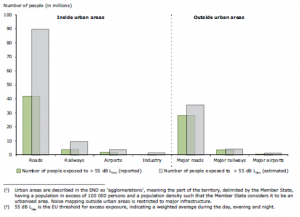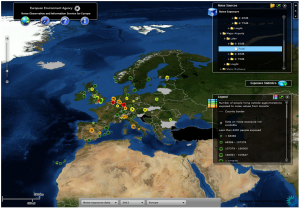Interfase-UAB, inside the ETC/ACM consortium, is responsible for the provision of support to EEA, the Member States and the EEA member countries on the environmental noise field: mainly supporting the collection and quality checking of noise data, assessing it and disseminating the main figures at European and country level.
The Environmental Noise Directive (END) entered into force in 2002, and based on the information compiled since that date, the first noise assessment report at EU level was developed and published together with the EEA, in December 2014.
The report contains already nearly two data reporting rounds of noise information, highlighting the noise sources areas where the END is of application and strategic noise maps and noise action plans being developed in those areas by the EEA member countries. The report focuses its assessment on the second reporting round (2010-2012), although some hints are also provided concerning the first reporting round (2005-2007-2009).
Some of the key messages that can be encountered in this first assessment are:
- Noise pollution is a major environmental health problem in Europe;
- Road traffic noise is the most dominant source of environmental noise with an estimated 125 million people affected by noise levels greater than 55 decibels (dB) Lden (day-evening-night level);
- Environmental noise causes at least 10000 cases of premature death in Europe each year and almost 20 million adults are annoyed and a further 8 million suffer sleep disturbance due to environmental noise;
- Political ambitions are high with the European Union’s (EU) Seventh Environmental Action Programme (7th EAP) containing the objective that noise pollution in the EU has significantly decreased by 2020, moving closer to World Health Organization (WHO) recommended levels;
- Lack of comparable and common assessment methods often causes significant inconsistencies in exposure estimates, between different countries, within a single country and across the two main reporting rounds.
Number of people exposed to noise in Europe > 55 dB Lden in EEA member countries (2012): reported and estimated data
You can download the full report in the following link: http://www.eea.europa.eu/publications/noise-in-europe-2014
But the collection of the noise information under the END premises is a continuous exercise. Member States, obliged to report mandatory dataflows every five years, can update the information reported at any time in between, which implies that the EEA and the UAB (under the ETC/ACM) are updating the noise database and disseminating the information on a yearly basis.
Latest information available at European level concerning strategic noise maps is available at: http://noise.eionet.europa.eu.
The information received concerning noise strategic maps is used to conform the noise indicator published yearly by the European Environment Agency, last one focused specifically on exposure to and annoyance by traffic noise: http://www.eea.europa.eu/data-and-maps/indicators/exposure-to-and-annoyance-by-1/assessment
Assessment exercises being developed at the moment go a bit further on some of the key messages highlighted in the Noise in Europe 2014 report and previous EEA and Expert Panel on Noise (EPoN) publications.
An improvement of the methodology being described in the Good practice guide on quiet areas, Technical Report 4/2014 (http://www.eea.europa.eu/publications/good-practice-guide-on-quiet-areas), is being proposed through an improved Quietness Suitability Index (QSI).
Maps, figures and graphs have been calculated to highlight the potential quiet areas at European and at country level, encountering a share of 18% of potential quiet areas of the European territory while noisy areas account for more than 33% of the complete territory.
The distribution of those quiet areas outside urban areas has been seen as strongly related to population density, so a key factor when planning those areas are their accessibility and the degree of protection that already have, both aspects analysed in this assessment.
Potential quiet areas in Europe, based upon Quietness Suitability Index (QSI)


